In this article, I want to walk you through the important concept in climatology i.e. Temperature Inversion for UPSC IAS Examination.
What is Temperature Inversion?
Under normal conditions, the temperature usually decreases with an increase in altitude in the troposphere at a rate of 1 degree for every 165 meters. This is called normal lapse rate, But on some occasions, the situations get reversed and the temperature starts increasing with height rather than decreasing. This is called temperature inversion.
Although the environmental lapse rate varies from place to place and from time to time, particularly in the lowest few hundred meters of the troposphere, the average rate of temperature change is about 6.5°C per 1000 meters (3.6°F 1000 feet). This is called the average lapse rate, or average vertical temperature gradient within the troposphere.
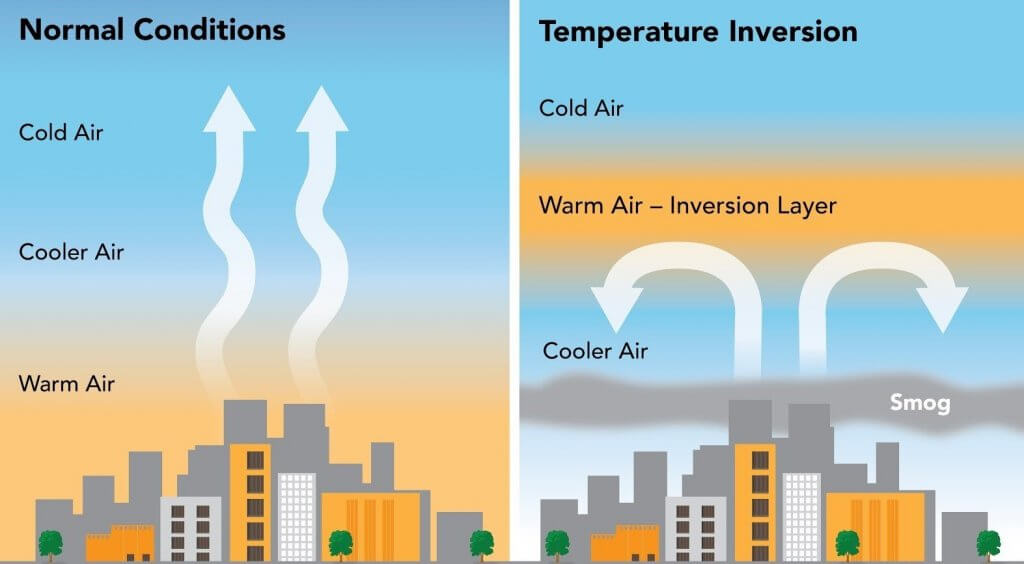
The average lapse rate tells us that if a thermometer measures the temperature 1000 meters above a previous measurement, the reading will be, on average, 6.5°C cooler. Conversely, if a second measurement is made 1000 meters lower than the first, the temperature will be about 6.5°C warmer.
Temperature Inversion or Thermal inversion
Usually, as we move up in the troposphere from the surface, the temperature decreases with an increase in altitude. But sometimes due to local conditions, the temperature, instead of decreasing, increases with height. This phenomenon is called temperature inversion (thermal inversion). This is also known as a negative lapse rate.
It is a reversal of the normal behavior of temperature in the troposphere. Under this meteorological phenomenon, a layer of warm air lies over the cold air layer.
It is caused in stack atmospheric conditions while sometimes, it occurs due to horizontal or vertical movement of air.
Temperature inversion is usually of short duration but quite common nonetheless.
Effects of temperature inversion
The inversion of temperature and its duration affects adversely the society and economy of the region of its occurrence. Some of the important consequences of temperature inversion are –
The occurrence of fog: there develop clouds in contact with the ground (fog) with visibility usually restricted to less than 1km. in the urban areas, the fog mixed with smoke takes the shape of smog. While fog is injurious to crops, the smog is considered a health hazard. In 1952, about 4000 people died of smog in London. Breathing problems, asthma, and bronchitis, etc. are common problems in Delhi and big cities of northern India during the winter season.
Road accidents: Visibility may be greatly reduced below the inversion due to the accumulation of dust and smoke particles. The frequency of roads, railways, and air accidents increases during foggy conditions due to low visibility. Trains and flights are often delayed.
Damage of crops: the winter crops like wheat, barley, mustard, vegetables, chilies, potato, etc. are seriously damaged. The sugarcane crop in the northern plains of India. Especially in UP, Punjab, and Haryana develops the disease of a red rod which reduces the sugar content.
Vegetation: Orchards are closely influenced by the inversion of temperature. The lower valleys of Alps Mountains are almost without settlements, while the upper slopes are inhabited.
Clouds: In regions where a pronounced low-level inversion is present, convective clouds can not grow high enough to produce showers.
Diurnal Variations: Inversions also affect diurnal variations in temperature. Diurnal variations tend to be very small.
Ideal Conditions For Temperature Inversion
- Long nights, so that the outgoing radiation is greater than the incoming radiation.
- Clear skies, which allow unobstructed escape of radiation.
- Calm and stable air, so that there is no vertical mixing at lower levels.
Types of Temperature Inversion
- Frontal inversion
- Temperature Inversion in Intermontane Valley
- Ground Inversion
- Subsidence Inversion
- Marine Inversion
1. Frontal inversion
- It is caused by the horizontal and vertical movement of air. The temperate cyclones are formed by the convergence of warm westerlies and cold polar air, and thus the warm air overlies the cold air. The presence of warm air above and cold air below reverses the normal lapse rate and inversion of temperature occurs.
- This kind of inversion has a considerable slope, whereas other inversions are nearly horizontal. In addition, humidity may be high, and clouds may be present immediately above it.
- This type of inversion is unstable and is destroyed as the weather changes.
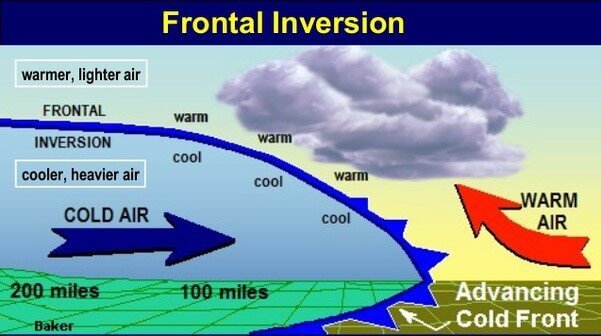
2. Temperature Inversion in Intermontane Valley (Air Drainage Type of Inversion)
- Sometimes, the temperature in the lower layers of air increases instead of decreasing with elevation. This happens commonly along a sloping surface.
- Here, the surface radiates heat back to space rapidly and cools down at a faster rate than the upper layers. As a result the lower cold layers get condensed and become heavy.
- The sloping surface underneath makes them move towards the bottom where the cold layer settles down as a zone of low temperature while the upper layers are relatively warmer.
- This condition, opposite to normal vertical distribution of temperature, is known as Temperature Inversion.
- In other words, the vertical temperature gets inverted during temperature inversion.
- This kind of temperature inversion is very strong in the middle and higher latitudes. It can be strong in regions with high mountains or deep valleys also.
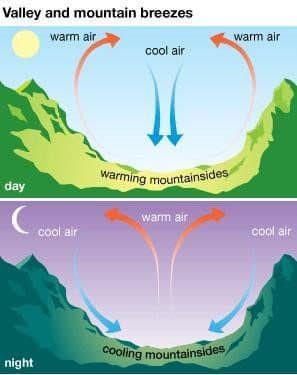
3. Ground Inversion (Surface Temperature Inversion)
- A ground inversion develops when air is cooled by contact with a colder surface until it becomes cooler than the overlying atmosphere; this occurs most often on clear nights when the ground cools off rapidly by radiation. If the temperature of surface air drops below its dew point, fog may result.
- This kind of temperature inversion is very common in the higher latitudes.
- A surface temperature inversion in lower and middle latitudes occurs during cold nights and gets destroyed during the daytime.
- This inversion, however, disappears with sunrise. The duration and height of surface inversion increase polewards. Following conditions are required for ground surface inversion:
- Long winter nights Cloudless calm skies
- Dry air and low relative humidity
- Calm atmosphere or slow movement of air Snow covered surface
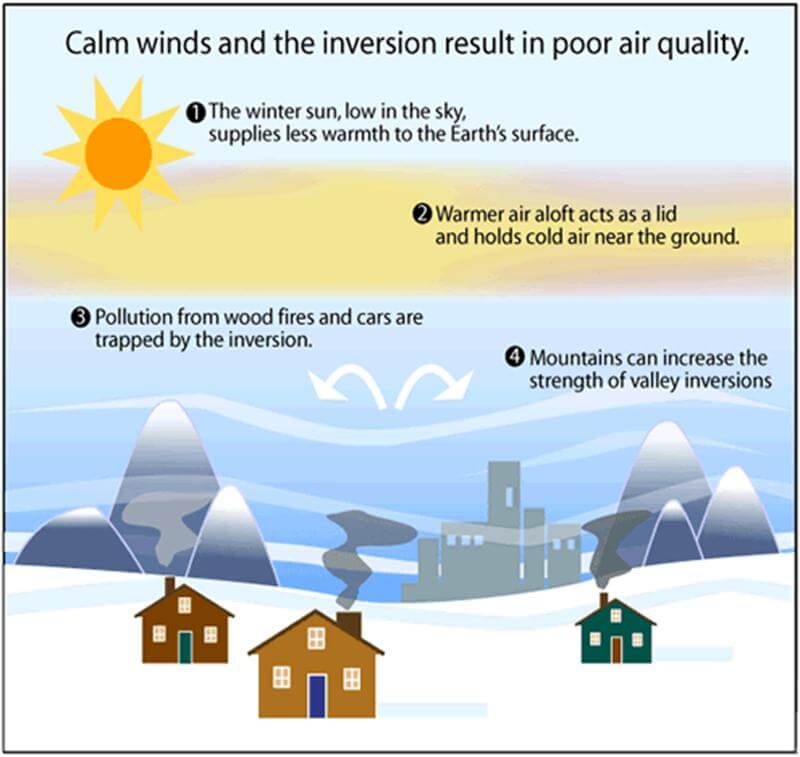
4. Subsidence Inversion (Upper Surface Temperature Inversion)
- A subsidence inversion develops when a widespread layer of air descends.
- The layer is compressed and heated by the resulting increase in atmospheric pressure, and as a result, the lapse rate of temperature is reduced.
- If the air mass sinks low enough, the air at higher altitudes becomes warmer than at lower altitudes, producing a temperature inversion.
- Subsidence inversions are common over the northern continents in winter (dry atmosphere) and over the subtropical oceans; these regions generally have subsiding air because they are located under large high-pressure centers.
- This temperature inversion is called upper surface temperature inversion because it takes place in the upper parts of the atmosphere.
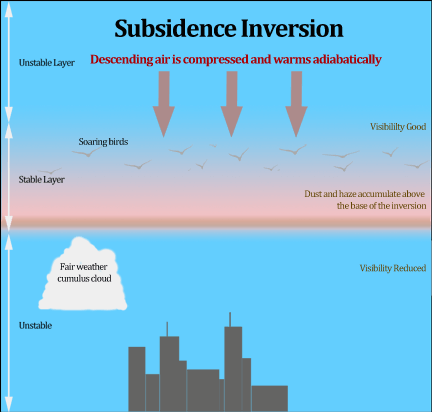
5. Marine Inversion
This occurs when cool, moist air that originates over the ocean is blown onto land by our prevailing westerly winds. The cool temperature of this air makes it denser, so it readily flows underneath the warmer, drier air that is present over the basin.
- Marine Inversions occur in places near large bodies of water, especially in the spring when the water is the most chilly.
- When air passes over these large bodies of water, it is cooled by the heat getting conducted from the air to the water.
- This cold air is then blown inland under the warmer air that is over the land, thus creating an inversion.
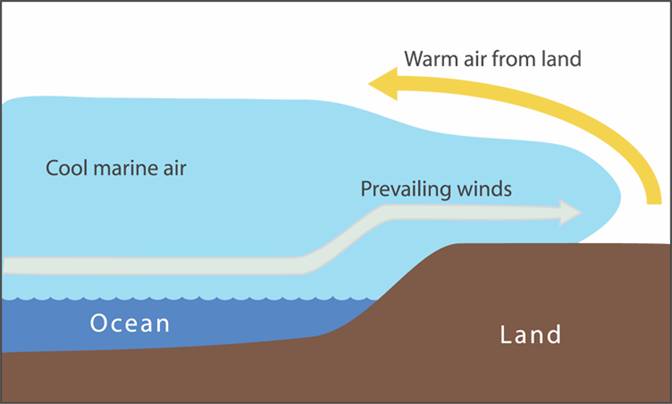
Economic Implications of Temperature Inversion
- Sometimes, the temperature of the air at the valley bottom reaches below freezing point, whereas the air at higher altitude remains comparatively warm. As a result, the trees along the lower slopes are bitten by frost, whereas those at higher levels are free from it.
- Due to the inversion of temperature, air pollutants such as dust particles and smoke do not disperse in the valley bottoms.
- Because of these factors, houses and farms in intermontane valleys are usually situated along the upper slopes, avoiding the cold and foggy valley bottoms. For instance, coffee growers of Brazil and apple growers and hoteliers of mountain states of the Himalayas in India avoid lower slopes.
- Fog lowers visibility affecting vegetation and human settlements.
- Less rainfall due to stable conditions.
UPSC Questions
1. What do you understand by the phenomenon of “temperature inversion” in meteorology? How does it affect the weather and habitants of the place?
1. It contains approximately 99% of the atmosphere’s water vapour and aerosols.
2. It is deeper in the tropics up to 12 miles and shallower near the polar regions, at 4.3 miles in summer and indistinct in winter.
3. Tropopause is the region of temperature inversion.
Which of the above statement(s) is/are correct?
(a) Only 1
(b) Only 2
(c) 1 and 3
(d) All of these
Ans: (d)
Explanation: The troposphere is the lowest portion of Earth’s atmosphere. It contains approximately 80% of the atmosphere’s mass and 99% of its water vapour and aerosols. The border between the troposphere and stratosphere, called the tropopause, is a temperature inversion region.
(a) Convection during daytime causes mixing of air and therefore, spreads up the wind near the surface.
(b) Temperature inversion prevents any exchange of air from the upper layer to the lower layer
(c) The Coriolis deflection id greater during daytime
(d) The conditions are quite a during night time
Ans: (b)
Explanation: Temperature inversion is an increase in temperature with height. During the temperature inversion, the normal vertical temperature gradient is inverted such that the air is colder near the surface of the earth. The cold air is near the surface will be stable and prevents any upward and lateral movement. It suppresses the convection by acting as a cap.
A. Horizontal
B. Left and right
C. Horizontal
D. Downward and Upward
Answer. D

Respected sir! Please available all geography notes in pdf form. This is very humble request to you sir! Thank you.
Amit Ji, my first priority is to write all notes on the website after that I will start the compilation of notes in pdf format and it will take lots of time for a single person, I would like to suggest to all my UPSC aspirants that please read articles again and again and make your own short notes for the final exam.
Sir please ,upload the remaining notes of topics . Your notes are really helpful.
Thanks a lot
I am working on the same. keep Reading
Will you be able to complete notes by MARCH /APRIL ??
Sorry, I will complete it before Mains 2021.
Thank you so much sir ! Looking forward .
I THINK YOU ARE GENEOUS AND I WANT TO WORK WITH YOU .
I AM A GEOGRAPHY TEACHER AND ALSO MEDITATION MENTOR . IN FUTURE IF YOU AGREE THEN WORK TOGETHER.
YOU ARE DOING VERY HARD WORK AND I APPRECIATE YOUR WORK .
Thank you.
very helpful